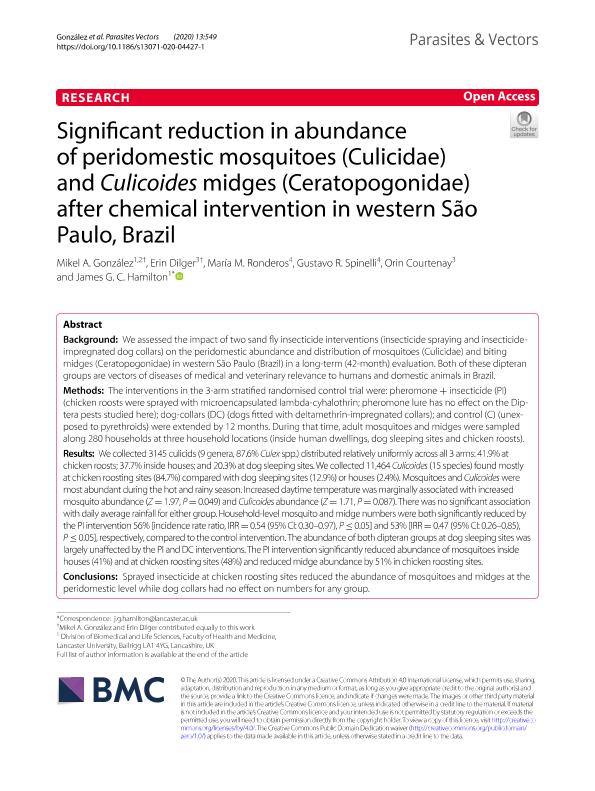Mostrar el registro sencillo del ítem
dc.contributor.author
González, Mikel A.
dc.contributor.author
Dilger, Erin
dc.contributor.author
Ronderos, Maria Marcela

dc.contributor.author
Spinelli, Gustavo Ricardo

dc.contributor.author
Courtenay, Orin
dc.contributor.author
Hamilton, James G. C.
dc.date.available
2021-10-14T13:54:51Z
dc.date.issued
2020-11-07
dc.identifier.citation
González, Mikel A.; Dilger, Erin; Ronderos, Maria Marcela; Spinelli, Gustavo Ricardo; Courtenay, Orin; et al.; Significant reduction in abundance of peridomestic mosquitoes (Culicidae) and Culicoides midges (Ceratopogonidae) after chemical intervention in western São Paulo, Brazil; BioMed Central; Parasites and Vectors; 13; 1; 07-11-2020; 1-13
dc.identifier.issn
1756-3305
dc.identifier.uri
http://hdl.handle.net/11336/143550
dc.description.abstract
Background: We assessed the impact of two sand fly insecticide interventions (insecticide spraying and insecticide-impregnated dog collars) on the peridomestic abundance and distribution of mosquitoes (Culicidae) and biting midges (Ceratopogonidae) in western São Paulo (Brazil) in a long-term (42-month) evaluation. Both of these dipteran groups are vectors of diseases of medical and veterinary relevance to humans and domestic animals in Brazil. Methods: The interventions in the 3-arm stratified randomised control trial were: pheromone + insecticide (PI) (chicken roosts were sprayed with microencapsulated lambda-cyhalothrin; pheromone lure has no effect on the Diptera pests studied here); dog-collars (DC) (dogs fitted with deltamethrin-impregnated collars); and control (C) (unexposed to pyrethroids) were extended by 12 months. During that time, adult mosquitoes and midges were sampled along 280 households at three household locations (inside human dwellings, dog sleeping sites and chicken roosts). Results: We collected 3145 culicids (9 genera, 87.6% Culex spp.) distributed relatively uniformly across all 3 arms: 41.9% at chicken roosts; 37.7% inside houses; and 20.3% at dog sleeping sites. We collected 11,464 Culicoides (15 species) found mostly at chicken roosting sites (84.7%) compared with dog sleeping sites (12.9%) or houses (2.4%). Mosquitoes and Culicoides were most abundant during the hot and rainy season. Increased daytime temperature was marginally associated with increased mosquito abundance (Z = 1.97, P = 0.049) and Culicoides abundance (Z = 1.71, P = 0.087). There was no significant association with daily average rainfall for either group. Household-level mosquito and midge numbers were both significantly reduced by the PI intervention 56% [incidence rate ratio, IRR = 0.54 (95% CI: 0.30–0.97), P ≤ 0.05] and 53% [IRR = 0.47 (95% CI: 0.26–0.85), P ≤ 0.05], respectively, compared to the control intervention. The abundance of both dipteran groups at dog sleeping sites was largely unaffected by the PI and DC interventions. The PI intervention significantly reduced abundance of mosquitoes inside houses (41%) and at chicken roosting sites (48%) and reduced midge abundance by 51% in chicken roosting sites. Conclusions: Sprayed insecticide at chicken roosting sites reduced the abundance of mosquitoes and midges at the peridomestic level while dog collars had no effect on numbers for any group.[Figure not available: see fulltext.].
dc.format
application/pdf
dc.language.iso
eng
dc.publisher
BioMed Central

dc.rights
info:eu-repo/semantics/openAccess
dc.rights.uri
https://creativecommons.org/licenses/by/2.5/ar/
dc.subject
ABUNDANCE
dc.subject
BRAZIL
dc.subject
CHICKENS
dc.subject
CULICIDAE
dc.subject
CULICOIDES
dc.subject
DISTRIBUTION
dc.subject
INSECTICIDE INTERVENTION
dc.subject
LAMBDA-CYHALOTHRIN
dc.subject
SPECIES COMPOSITION
dc.subject.classification
Zoología, Ornitología, Entomología, Etología

dc.subject.classification
Ciencias Biológicas

dc.subject.classification
CIENCIAS NATURALES Y EXACTAS

dc.title
Significant reduction in abundance of peridomestic mosquitoes (Culicidae) and Culicoides midges (Ceratopogonidae) after chemical intervention in western São Paulo, Brazil
dc.type
info:eu-repo/semantics/article
dc.type
info:ar-repo/semantics/artículo
dc.type
info:eu-repo/semantics/publishedVersion
dc.date.updated
2021-09-06T17:08:58Z
dc.journal.volume
13
dc.journal.number
1
dc.journal.pagination
1-13
dc.journal.pais
Reino Unido

dc.journal.ciudad
Londres
dc.description.fil
Fil: González, Mikel A.. Lancaster University; Reino Unido
dc.description.fil
Fil: Dilger, Erin. University of Warwick; Reino Unido
dc.description.fil
Fil: Ronderos, Maria Marcela. Universidad Nacional de La Plata. Facultad de Ciencias Naturales y Museo. División Entomología; Argentina. Consejo Nacional de Investigaciones Científicas y Técnicas. Centro Científico Tecnológico Conicet - La Plata; Argentina
dc.description.fil
Fil: Spinelli, Gustavo Ricardo. Universidad Nacional de La Plata. Facultad de Ciencias Naturales y Museo. División Entomología; Argentina. Consejo Nacional de Investigaciones Científicas y Técnicas. Centro Científico Tecnológico Conicet - La Plata; Argentina
dc.description.fil
Fil: Courtenay, Orin. University of Warwick; Reino Unido
dc.description.fil
Fil: Hamilton, James G. C.. Lancaster University; Reino Unido
dc.journal.title
Parasites and Vectors

dc.relation.alternativeid
info:eu-repo/semantics/altIdentifier/doi/https://doi.org/10.1186/s13071-020-04427-1
dc.relation.alternativeid
info:eu-repo/semantics/altIdentifier/url/https://parasitesandvectors.biomedcentral.com/articles/10.1186/s13071-020-04427-1
Archivos asociados
